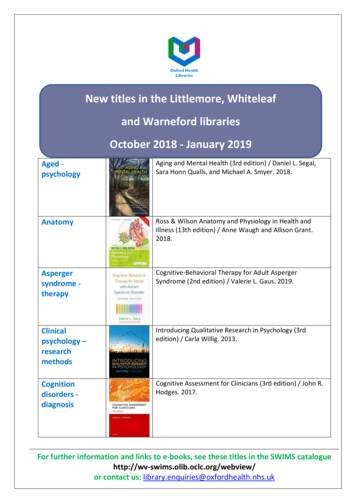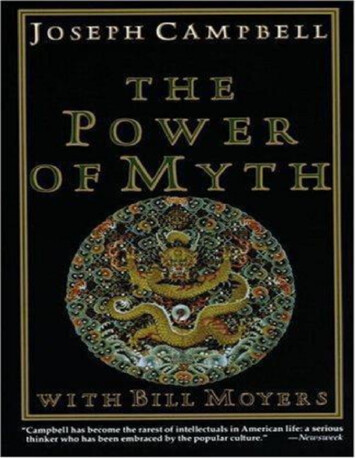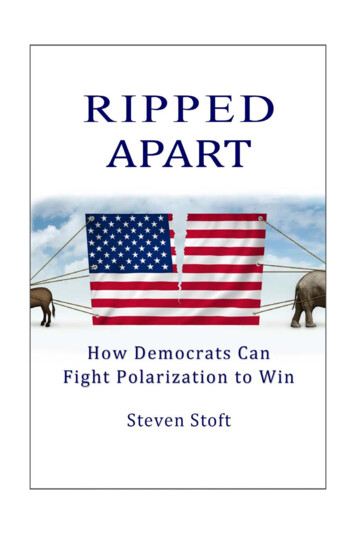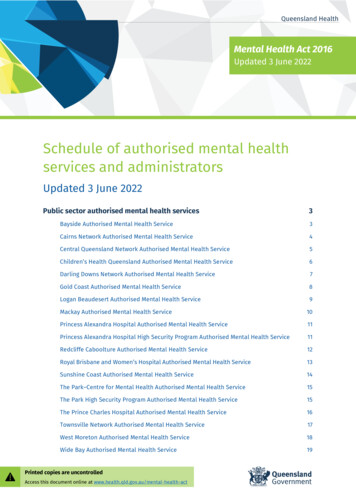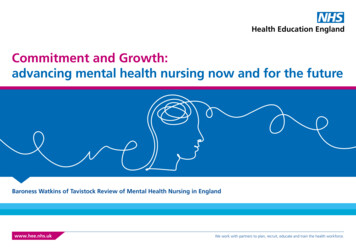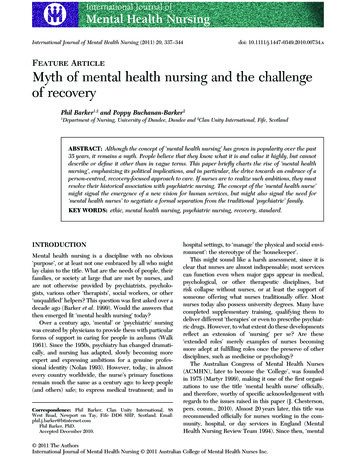
Transcription
International Journal of Mental Health Nursing (2011) 20, 337–344Feature Article734doi: 10.1111/j.1447-0349.2010.00734.x337.344Myth of mental health nursing and the challengeof recoveryPhil Barker1,2 and Poppy Buchanan-Barker21Department of Nursing, University of Dundee, Dundee and 2Clan Unity International, Fife, ScotlandABSTRACT: Although the concept of ‘mental health nursing’ has grown in popularity over the past35 years, it remains a myth. People believe that they know what it is and value it highly, but cannotdescribe or define it other than in vague terms. This paper briefly charts the rise of ‘mental healthnursing’, emphasizing its political implications, and in particular, the drive towards an embrace of aperson-centred, recovery-focused approach to care. If nurses are to realize such ambitions, they mustresolve their historical association with psychiatric nursing. The concept of the ‘mental health nurse’might signal the emergence of a new vision for human services, but might also signal the need for‘mental health nurses’ to negotiate a formal separation from the traditional ‘psychiatric’ family.KEY WORDS: ethic, mental health nursing, psychiatric nursing, recovery, standard.INTRODUCTIONMental health nursing is a discipline with no obvious‘purpose’, or at least not one embraced by all who mightlay claim to the title. What are the needs of people, theirfamilies, or society at large that are met by nurses, andare not otherwise provided by psychiatrists, psychologists, various other ‘therapists’, social workers, or other‘unqualified’ helpers? This question was first asked over adecade ago (Barker et al. 1999). Would the answers thatthen emerged fit ‘mental health nursing’ today?Over a century ago, ‘mental’ or ‘psychiatric’ nursingwas created by physicians to provide them with particularforms of support in caring for people in asylums (Walk1961). Since the 1950s, psychiatry has changed dramatically, and nursing has adapted, slowly becoming moreexpert and expressing ambitions for a genuine professional identity (Nolan 1993). However, today, in almostevery country worldwide, the nurse’s primary functionsremain much the same as a century ago: to keep people(and others) safe; to express medical treatment; and inCorrespondence: Phil Barker, Clan Unity International, 88West Road, Newport on Tay, Fife DD6 8HP, Scotland. Email:phil.j.barker@btinternet.comPhil Barker, PhD.Accepted December 2010.hospital settings, to ‘manage’ the physical and social environment’: the stereotype of the ‘housekeeper’.This might sound like a harsh assessment, since it isclear that nurses are almost indispensable; most servicescan function even when major gaps appear in medical,psychological, or other therapeutic disciplines, butrisk collapse without nurses, or at least the support ofsomeone offering what nurses traditionally offer. Mostnurses today also possess university degrees. Many havecompleted supplementary training, qualifying them todeliver different ‘therapies’ or even to prescribe psychiatric drugs. However, to what extent do these developmentsreflect an extension of ‘nursing’ per se? Are these‘extended roles’ merely examples of nurses becomingmore adept at fulfilling roles once the preserve of otherdisciplines, such as medicine or psychology?The Australian Congress of Mental Health Nurses(ACMHN), later to become the ‘College’, was foundedin 1975 (Martyr 1999), making it one of the first organizations to use the title ‘mental health nurse’ officially,and therefore, worthy of specific acknowledgement withregards to the issues raised in this paper (J. Chesterson,pers. comm., 2010). Almost 20 years later, this title wasrecommended officially for nurses working in the community, hospital, or day services in England (MentalHealth Nursing Review Team 1994). Since then, ‘mental 2011 The AuthorsInternational Journal of Mental Health Nursing 2011 Australian College of Mental Health Nurses Inc.
338P. BARKER AND P. BUCHANAN-BARKERhealth nursing’ has spread around the globe, althoughin Europe, Horatio still remains an association of ‘psychiatric nurses’ (Horatio 2010). However, the differencebetween ‘mental health’ and ‘psychiatric’, or ‘mental’nursing, still remains unclear (Cutcliffe & Ward 2006,p. 22). In a very important sense, ‘mental health nursing’is a ‘myth’, in the classic sense, reflecting how nurseswould ‘like’ to be: a professional aspiration, rather than apractical reality. Most of the writing and talking about‘mental health nursing’ is mere ‘ideology’: the collectedideals and social aspirations of some sections of the traditional ‘psychiatric nursing’ discipline (Chambers 2006).However, if nurses brought this ideology to life, theirpurpose might become clearer.MERCURIAL NATURE OF MENTALHEALTH NURSINGAs ideology, ‘mental health nursing’ provides a linguisticmeans by which practitioners can feel better about themselves. In England, Norman and Ryrie (2004) suggestedthat this might be its only function:In part this change in terminology would appear to reflecta desire by nurses to establish their profession as distinctfrom the discipline of psychiatry and also to find a morepositive identity as people who can help people who arementally ill [sic] become mentally healthy. (p. 67)Despite its international popularity, the ideologicalshift towards ‘mental health nursing’ is often blurred byblending ‘psychiatric’ with ‘mental health ‘nursing. ForCutcliffe and Ward (2006), this terminological confusionwas key to all the theoretical and philosophical debates inthe field, leading Collins (2006) to argue that it might be‘time to consider whether psychiatric nurses are nurses atall’. Such a radical stand would, however, require nursesto split from their historical roots: ‘free from the influences of the “medical father” and the “nursing mother” ’(Collins 2006, p. 50).‘Mental health nursing’ implies something more meaningful, more egalitarian, more ‘health promoting’, andtherefore, more liberating than traditional psychiatricnursing. This was signalled in the Australian College ofMental Health Nurses’ (2010) definition:(A mental health nurse) holds a specialist qualificationin mental health. Taking a ‘holistic’ approach, guided byevidence, the mental health nurse ‘works’ in ‘collaboration’ with people who have ‘mental health issues’, theirfamily and community, towards ‘recovery’ as defined bythe individual. (p. 5. Emphasis added)In contemporary international practice, the terms‘psychiatric’ and ‘mental health’ nursing are used almostinterchangeably. Nolan’s (1993) groundbreaking ‘historyof mental health nursing’ referred, in the main, to ‘psychiatric’ nursing, since the concept of ‘mental health’nursing was introduced officially into the UK only adecade before the publication of his book. However, asChambers argued: ‘Logically . . . those nurses workingwith the mentally ill should, at the very least, be called“mental illness nurses” or even “nurses of the mentallyill[sic]” ’ (Chambers 2006, p. 44). If ‘mental health’nursing is not simply rebranding – a piece of linguisticcosmetic surgery – then it must refer to something different from ‘psychiatric’ nursing.In an ongoing study, we asked mental health nurses toprovide brief, concise descriptions of what is ‘psychiatricand mental health nursing?’ and ‘how do nurses ‘practice’it?’ (Barker & Buchanan-Barker 2008) We offeredtwo-line definitions of medicine, psychology, and socialwork, drawn from Web dictionaries, to act as a guide.Two-hundred practitioners, leaders, researchers, andeducators from around the world were invited to ‘define’and ‘describe’ their discipline in a way that ‘could beunderstood by the layperson’. Many admitted that thesewere ‘difficult questions’, finding it hard to offer definitions and descriptions that were not jargon-ridden summaries of eminent theorists. This led us to wonder howrecruitment is encouraged, if prospective mental healthnursing students cannot be offered a simple definition ofits purpose and function.Only a few respondents distinguished between ‘psychiatric’ and ‘mental health’ nursing. One professor ofnursing from the USA said that the field was divided intotwo ‘camps’. The first was:A subservient discipline and an extension of psychiatry’ssocial control mechanism(s) for the policing, containment, and correction of already-marginalized people,which carried out a number of defensive, custodial,uncritical, and often iatrogenic practices and treatments,based on a false epistemology and misrepresentation ofwhat are, by and large, ‘human problems of being’, ratherthan so-called ‘mental illnesses’.The second was:A specialty craft that operates primarily by workingalongside people with mental health problems; helpingindividuals and their families find ways of coping withthe here and now (and past); helping people discoverand ascribe individual meaning to their experiences; andexploring opportunities for recovery, reclamation, and 2011 The AuthorsInternational Journal of Mental Health Nursing 2011 Australian College of Mental Health Nurses Inc.
MYTH OF MENTAL HEALTH NURSINGpersonal growth, all through the medium of the therapeutic relationship.People considering undertaking nurse training mightwonder if they have a choice to join ‘either’ the first ‘or’the second of these ‘camps’. By contrast, a distinguishednurse leader from the UK said that mental health nursingcovered:A broad and moveable spectrum of roles, responsibilities,and practices defined by the economics, institutions,and policies of the day, which meant that this particularbranch of nursing could not be defined.PATERNALISM AND THE HISTORY OFPSYCHIATRIC NURSINGClearly, there are risks in being defined by the ‘economic’,‘institutional’, and ‘political’ influences of the day. Thenurses who participated in the mass involuntary euthanasia programme during the Holocaust were merely conforming to the social and political standard of nationalsocialism (Benedict & Kuhla 1999). The countlessnumber of nurses in psychiatric hospitals who participated in electroshock, psychosurgery, enforced sedation,the application of wet packs, restraints, and seclusionwere also conforming to an image of nursing practice setfor them by someone in authority (Peplau 1994). If nursesdo not define themselves professionally, they risk beingdefined and directed by others who might have verydifferent agendas. Arguably, nurses’ uncertainty overdefining themselves and their inclination to serve almostanyone in authority lies in their history. In the mid19th century, the physician, John Connolly, famouslyremarked:All (the physicians’) plans, all his care, all his personallabour, must be counteracted, if he has attendants whowill not observe his rules. (Connolly 1856, p. 37)Such attitudes led to the development of trainingprogrammes for attendants, created by physicians,largely to meet the physicians’ needs (Walk 1961). InCohen’s (1981) view, medical patronage had long beennursing’s biggest problem: ‘Nightingale defined thenursing role as handmaiden to the physician, and ithas remained so. Handmaidens are not professionals’(Cohen 1981, p. 140). Doubtless, most contemporary‘mental health nurses’ would lay a strong claim to professional status. However, this only makes the inconsistencies and uncertainties over the definition of thediscipline all the more intriguing.339Few psychiatric-mental health nurses give their historymore than a casual glance, which might be reasonable,since it is not an attractive story. When trained nursesreplaced Connolly’s untrained attendants at the beginning of the 20th century, they continued the attendants’custodial function, but also provided more technicalsupport to physicians, becoming the administrators ofvarious ‘patient management’ methods, most of whichhad disastrous effects on the people concerned (Whitaker2001). Given their ‘medical-expressive’ role (Barker 1990;Peplau 1994), nurses were either responsible for, orassisted in, the delivery of all such ‘treatments’, the validity and usefulness of which they never questioned, sincethey carried the stamp of medical authority. Unmodifiedelectroshock, insulin coma, and lobotomy might behistory, but forced drug administration continues, as doesthe widespread practice of disinformation and deceitoften involved when nurses try to encourage peopleto take psychiatric drugs, which they do not want, orinterpret their problems from a psychiatric perspective(Jackson 2005; Lakeman & Cutcliffe 2009).A recent Irish study provides a fitting example, wherenurses avoid telling people of the likely effects of certaindrugs for fear that they would stop taking them (Higginset al. 2006). Although defended as ‘caring concern’, thiswas paternalism writ large. The many ‘side-effects’ ofneuroleptic and antidepressant drugs are well known andinclude pseudo-Parkinsonism; shrinking of brain mass;increased risk of impotence, obesity, seizures, and diabetes; enlarged breast tissue in men; dulling of the intellect;and heart problems, which might result in death (e.g.Wikipedia 2010). Before offering or recommending suchdrugs, any health-care professional should provide theperson with a full explanation of all such risks. Failureto do so would be dishonest, unethical, dangerous, andillegal. It is only surprising that there is not more litigationrelated to the kind of ‘paternalistic’ practices described inHiggins’s study.PSYCHIATRIC MYTHOLOGY ANDPSYCHIATRIC NURSINGMisplaced compassion is part of the paternalistic medicaltradition: doing things, allegedly, in the patient’s bestinterests (Breeze 1998; Szasz 1998), and nurses mighthave embraced this tradition even more fervently thanpsychiatrists. However, it has become clear that much ofthe paternalistic ‘wisdom’ concerning ‘mental illness’ andits ‘treatment’, especially by drugs, is grossly exaggeratedwhere it is not complete mendacity. Whitaker (2010)noted: 2011 The AuthorsInternational Journal of Mental Health Nursing 2011 Australian College of Mental Health Nurses Inc.
340P. BARKER AND P. BUCHANAN-BARKERFor the past twenty-five years, the psychiatric establishment has told us a false story. It told us that schizophrenia, depression and bipolar illness are known to be braindiseases, even though . . . it can’t direct us to any scientificstudies that document this claim. It told us that psychiatric medications fix chemical imbalances in the brain,even though decades of research failed to find this tobe so. . . . Most important of all, the psychiatric establishment failed to tell us that the drugs worsen long-termoutcomes. (p. 358)The idea of the ‘chemical imbalance’, first developed inthe 1950s (Valenstein 1998), became the most popularmyth related to of the causation of different ‘mental illnesses’, providing a fitting rationale for drug treatment.The ‘myth of the chemical cure’ was then sold as a scientific fact to patients and the public alike (Moncrieff 2009),despite the fact that no evidence existed to support theidea that ‘schizophrenia’, ‘bipolar disorder’, or ‘depression’ arose from such an ‘imbalance’. (Our use of ‘scarequotes’ reflects our belief that these ‘disorders’ are notlegitimate forms of bodily disease or illness.) Moncrieff(2009) and Whitaker (2010) illustrated how drugs offeredas a solution became, for many, a cure that was worse thanthe hypothetical ‘disease’. Hyman, the eminent US neurologist, was Director of the National Institute for MentalHealth when, with a colleague, he first described how ‘all’psychiatric drugs threw the brain into a state of chemicalchaos, creating ‘perturbations in neurotransmitter functions’ (Hyman & Nestler 1996). Hyman’s view thatprolonged use of such drugs resulted in ‘substantial andlong-lasting alterations in neural function’ showed thatany ‘chemical imbalance’ that might exist in the brain ofpeople with ‘mental illness’ was produced by long-termusage of psychotropic drugs, ‘not’ by some putative‘mental illness’.Whitaker’s (2010) review of the scientific literature onthe development of psychotropic drugs formed the basisof his thesis, that through its rash and unscrupulous advocacy of such drugs, psychiatry had nurtured an epidemicof ‘mental illness’. Many of today’s ‘mental health nurses’are either unaware or choose to forget that recoveryrates from so-called ‘serious mental illness’ were far better‘before’ the introduction of psychiatric drugs in the mid1950s than they are today. It is commonly believed thatthe deinstitutionalization programme was made possible‘only’ through the introduction of neuroleptics. This ispsychiatric mythology. As Healy et al. (2005, p. 28) noted,few people are aware that the asylum population in Japan‘quadrupled’ following the introduction of chlorpromazine, rather than leading to the closure of the institution.More importantly, numerous longitudinal studies (e.g.Harding et al. 1987; Harrow & Jobe 2007; Jablensky et al.1992) demonstrated that people with diagnoses of ‘schizophrenia’ and ‘bipolar disorder’ fared better in the longterm if they ‘did not’ receive psychiatric drugs or gradually‘discontinued’ their use. Despite this evidence, the European Convention on Human Rights, for example, exemptspeople with mental illnesses from its protection (Warneet al. 2010), with the result that, in most countries, peoplewith ‘serious mental illness’ can be forced by law to takepsychiatric drugs, which might cause them permanentand disabling physical damage.Many mental health professionals would argue thatdrug companies have delivered ‘new and improved’ drugtreatments, especially those who have developed sophisticated programmes to nurture adherence to drugtreatment regimes, who argue, for example, that ‘pooradherence increases morbidity and reduces a patient’squality of life’ (Anderson et al. 2010, p. 341). This isnot the place to rehearse these arguments in any detail.However, Lakeman and Cutcliffe (2009) have at leastprefaced the case against ‘pharmaco-centrism’ whichbedevils contemporary ‘mental health nursing’.‘Schizophrenia’ and ‘bipolar disorder’ are frequentlycharacterized as ‘malignant’ forms of ‘mental illness’,requiring prompt medical intervention through drugtreatment, usually for the rest of the person’s life. If evidence existed that a significant number of people withphysical malignancies, such as carcinomas, could recover‘without’ either surgical or drug treatment, then the scientific and public view of cancer would change irrevocably. Yet a significant number of people ‘recover’ from‘schizophrenia’, ‘bipolar disorder’, and drug and alcohol‘addictions’, either through the ‘administration’ of socialsupport or simply by ‘talking’ about their problems.Despite this evidence, the received view endures thatthese states are manifestations of ‘illness’ or ‘disease’requiring medical treatment. It is difficult to counter theargument made by Whitaker (2010) and Mosher et al.(2004a), among others, that the ‘pharmaco-centrism’ incontemporary mental health services is a function of successful marketing by drug companies, rather than deriving from scientific research.Although much of this emergent critique of psychiatricpractice is focused on psychiatrists, it implicates psychiatric nurses, without whom the machinery of psychiatrycould not operate. Where psychiatric nurses are notactive advocates of Lakeman and Cutcliffe’s ‘pharmacocentrism’, they appear to display little in the way of activeresistance. This might well be typical of their traditionallyconservative outlook. As Nolan (1993) observed, psychiatric nurses ‘have embodied traditional values of 2011 The AuthorsInternational Journal of Mental Health Nursing 2011 Australian College of Mental Health Nurses Inc.
MYTH OF MENTAL HEALTH NURSINGsubservience to the system and preservation of the statusquo. Theirs has been a ‘victim role’ and by deflectingresponsibility for the failures of psychiatry onto doctors,patients, or the institution, have made themselves, somewould claim, obstacles to progress’ (p. 159).PERSONS AND RECOVERYMuch of the traditional discourse on psychiatric–mentalhealth nursing remains focused on the treatment ormanagement of ‘patients’. Having coined the term ‘nurse–patient relationship’, in her last major paper, Peplau(1995) turned her attention away from ‘patients’ to thesubject of ‘persons’:Nurses claim that advocacy for patients, and consideration of their needs and interests as persons, havingdignity and worth, are primary values inherent in thedesign and execution of nursing services. In keeping withthese claims, it would behoove nurses to give up thenotion of a disease, such as schizophrenia, and to thinkexclusively of patients as persons. (p. 2)Peplau might be the most cited author in the nursingliterature, but few nurses today practice what shepreached at the end of her life. The most cursory trawlof any psychiatric–mental health nursing journal revealsthat many nurses are reluctant to give up the notion of‘patients’, ‘diseases’, or ‘illnesses’, such as schizophrenia.However, Peplau might have anticipated the ‘personfocus’ of recovery (Barker 2001), only beginning nowto be embraced, officially, by mental health nursing. Ina highly-significant development, the Standards ofPractice for Australian Mental Health Nurses 2010articulated five core values underpinning practice. Theseincluded:. . . acknowledging the personal experience and expertiseof the individual, supporting their potential for recoveryand assisting them to achieve optimal quality of life.(ACMHN 2010, p. 5)This implies that at least one purpose of nursing is tohelp people live their lives in the way they see fit. This isdeveloped further in Standard 3:. . . the Mental Health Nurse develops a therapeutic relationship that is respectful of the individual’s choices,experiences and circumstances. This involves buildingon strengths, holding hope and enhancing resilience topromote recovery – later defined as a subjective experience, defined by the individual. (ACMHN 2010, p. 10)341GRASPING THE NETTLE OF THERECOVERY ETHICAlthough necessarily vague, the ACMHN standards represent important examples of attempts to articulate the‘purpose’ of mental health nursing. We singled out forconsideration some of the ACMHN standards, since theyrepresent the expressed views of members of the discipline itself, rather than ambitions made on behalf of thediscipline by politically-elected or otherwise politicallymotivated groups called upon to conduct ‘reviews’ ofnursing, as so often prevails in other countries (e.g.Department of Health 2006). Moreover, the ACMHNstandards also appear to distinguish ‘mental healthnursing’ from the traditional practice of ‘psychiatricnursing’. This is expressed most perhaps by the emphasison ‘values’.The ACMHN concept of ‘mental health nursing’appears focused on helping people live their lives ‘on theirown terms’, echoing Barker’s concept of ‘trephotaxis’:Although we may help people to change in some way, wedo not change people directly. Certainly we do not healpeople, or otherwise make them whole . . . I have come toaccept that while helping people always involves change,it never involves a return to previous functioning: itis always a forward change. I have called this approachtrephotaxis, which in the original Greek would mean the‘provision of the necessary conditions for the promotionof growth and development. (Barker 1989, p. 138)This contrasts starkly with ‘psychiatric nursing’, whichappears to be focused primarily on the managementof some hypothetical ‘mental disease’ or ‘illness’, andusually involves ‘treating’ the person by some medicalmeans, and if necessary, by force. In this sense, ‘mentalhealth’ and ‘psychiatric’ nursing could not be moredifferent.The ideal at the heart of the ‘mental health nursing’‘ideology’ embraced by the ACMHN standards, reflectsan understanding of nursing in its purest sense. TheEnglish word ‘nursing’ derives from the Old French‘nourice’, meaning to nourish. Therefore, nursing impliesthe provision of the conditions necessary for a person tothrive, grow, and develop (Barker 1989), using whateverresources are available, complemented by the nurse’scompassionate support (Barker 2000).We searched the psychiatric–mental health literaturefor models of practice that met the criterion of ‘nourishment through interpersonal caring’. The examples thatexist are more often than not provided by psychiatristsand psychologists who have moved beyond the limits oftheir core discipline. Arguably, the most famous example 2011 The AuthorsInternational Journal of Mental Health Nursing 2011 Australian College of Mental Health Nurses Inc.
342P. BARKER AND P. BUCHANAN-BARKERof ‘nourishing nursing’ was Loren Mosher’s work with theSoteria project in California in the 1970s and 1980s(Mosher et al. 2004b). Mosher showed how compassionate caring, without the use of psychiatric drugs, couldhelp people grow and develop through the experienceso-called ‘schizophrenia’.Another psychiatrist, Ed Podvoll, was the inspirationfor the Windhorse projects in Colorado and Massachusetts, which realized what Podvoll called a genuinenursing of the mind (Podvoll 1991). Distressed peoplewere helped to live ordinary everyday lives with nothingmore than careful support of caring companions.In Finland, another psychiatrist, Yrjo Alanen, developed his needs-adapted model in Turku, which alsodemonstrated that careful listening, without neurolepticdrugs, could help people reveal the meaningful storiesembedded in so-called psychotic states, and in so doing,helping the person construct a new ‘self-narrative’ forgoing forwards (Alanen 1997). Alanen’s work has beendeveloped further by Jaako Seikkula in his ‘open-dialogue’approach (Seikkula et al. 2006). Like the others, Seikkulaembraces the virtues of humility, respect, and carefulattentive listening. All three are examples of ‘trephotaxis’,although Mosher and Podvoll chose to work with staffchosen for their human qualities, rather than professionalnursing qualification.The ACMHN standards and their underpinning valuessignal an ambition to reinforce, or perhaps establishofficially for the first time, a different kind of nursing forpeople experiencing the problems in living, commonlycalled ‘mental illness’. This initiative is laudable, but notwithout potential problems. As Glover (2005) noted, it isone thing to embrace the recovery ethic, and quiteanother to shift towards a recovery-based paradigm. Inthe context of the ACMHN’s expressed ambition to locate‘recovery’ at the heart of ‘holistic’ mental health nursingpractice, a number of questions might be asked. Thesemight include the following.Could a ‘mental health nurse’ fulfil the ACMHNstandards ‘and’ be involved in: The administration of psychiatric drugs or any otherform of treatment ‘against’ a person’s expressedwishes? The use of coercive or constraining practices, such as‘control and restraint’ or ‘seclusion’? Any programme that encourages individuals or theirfamilies to adopt a psychiatric view of their ‘symptoms’ of ‘mental illness’, rather than assist people todevelop their own understanding of their problems inliving?CONCLUSIONOver 20 years ago, Barker (1989) said that his articulationof ‘trephotaxis’ served: ‘little other function than symbolicprotection from those who would define our art for us’ (p.140). Perhaps the ACMHN standards represent a significant advance on that ‘symbolic protection’, as the Collegeseeks to mould the discipline in the image of the ideas itvalues most. However, the emphasis given to valuing theactive ‘person focus’ of partnerships, personalized notionsof recovery, and respect for human rights might fly in theface of contemporary forms of ‘evidence-based practice’,which remain ‘patient focused’ and paternalistic, wherethey are not actually coercive and dehumanizing. TheACMHN standards appear to represent an important stepforward in clarifying the fundamental purpose of mentalhealth nursing. However, that step might also require thediscipline to reconsider its relationship to ‘psychiatric’nursing, if not also the traditional family of psychiatry,which might not share the value base of mental healthnursing.Five years ago we surveyed 100 colleagues in differentcountries around the world. Our question was simple:Could someone with a ‘conscientious objection’ to ‘any’form of coercive practice, train ‘and’ qualify as a mentalhealth nurse? The unanimous response was ‘no’. Severaleducators said: ‘Such a person could study and qualify,but if they confessed such a view at interview, theywould be unlikely to gain employment in “mainstreampractice” ’.We are not sure if the people who framed theACMHN standards intended to make a radical statement about mental health nursing and mainstreampractice. At least on paper, the standards raise manychallenging questions about the relationship betweenthe College’s vision for the future of mental healthnursing, the shadow cast by psychiatric nursing of old,and their common roots in the mental health field.Whatever its potential, however, ‘mental health nursing’remains a ‘myth’ in the sense that the concept reflectshow nurses would ‘like’ to be: a professional aspiration,as expressed by the ACMHN standards perhaps, ratherthan a widespread contemporary reality. What is clear,beyond dispute, is that the days where nurses debatedwhat to call themselves appears to be over. Now nursesappear to be begging the question: ‘What do we “do?”’to merit the title ‘mental health nurse’ and ‘Why do wedo this, rather than anything else?’ The answers to suchquestions signal a future form of practice that mightdiffer significantly from the conservative traditions of thepsychiatric nursing past. 2011 The AuthorsInternational Journal of Mental Health Nursing 2011 Australian College of Mental Health Nurses Inc.
MYTH OF MENTAL HEALTH NURSINGREFERENCESAlanen, Y. O. (1997). Schizophrenia – Its Origins and NeedAdapted Treatment. London: Karnac.Anderson, K. H.
Feature Article _734 337.344 Myth of mental health nursing and the challenge of recovery Phil Barker1,2 and Poppy Buchanan-Barker2 1Department of Nursing, University of Dundee, Dundee and 2Clan Unity International, Fife, Scotland ABSTRACT: Although the concept of 'mental health nursing' has grown in popularity over the past 35 years, it remains a myth. People believe that they know what .

